

From: Berhane Habtemariam (Berhane.Habtemariam@gmx.de)
Date: Mon Feb 08 2010 - 15:47:50 EST
Operation Fenkil: The Major Operation That Heralded Eritrea's Total
Liberation
Mansour Nouredin, Feb 8, 2010
http://www.shaebia.org/artman/uploads/01_069.jpg
The month of February marks Fenkil Operation which is one of the historic
victories in the 30 year-long Eritrean struggle for independence. The
operation heralded that the clock was racing against the downfall of the
brutal Derg regime. Following the operation, Eritrea's liberation already
became apparent as the then Secretary General of the Eritrean People's
Liberation Front, comrade Isaias Afewerki, said in an interview: "Eritrea's
independence is only a matter of months".
>From 8 to 10 February, 1990, the gallant Eritrean freedom fighters scored a
decisive military victory over the then biggest army in Sub-Saharan Africa
armed to the teeth with sophisticated Soviet weaponry in contrast to the
Eritrean fighters' modest arsenals coupled with high morale and patriotism.
"The operation was a pinnacle of success to the EPLF besides proving its
steadfastness and just cause," says Asmerom Habtemariam a veteran fighter
and one of the first journalists of Radio Dimtsi Hafash (Voice of the Broad
Masses). "Next to the demise of Nadew command, the collapse of the Ethiopian
army in Operation Fenkil was another crucial turning point in the history of
the armed struggle," he added.
http://www.shaebia.org/artman/uploads/02_047.jpg
* The demise of Nadew Command
The demise of the Nadew command, a fortified enemy command of nine years
within 48 hours (17 March to 19 March 1988) was a bitter pill to swallow.
The victory, resulting in the liberation of the town of Afabet, was equated
by the renowned British historian Basil Davidson to the Battle of Dien Bien
Phu, which put an end to French colonialism in Vietnam. (The Viet Minh
communist <http://en.wikipedia.org/wiki/Revolutionary> revolutionaries won
over the
<http://en.wikipedia.org/wiki/French_Far_East_Expeditionary_Corps> French
Far East Expeditionary Corps and ended the latter's colonization in the
country in 1954 <http://en.wikipedia.org/wiki/First_Indochina_War> .)
"The demise of the Nadew command was one of the major successes that
demonstrated the change of balance of power and the upper hand of the EPLF
over a heavily armed military regime aided by Soviet military advisors,"
added Asmerom.
"With its 20.000 well armed military force equipped with sophisticated
motorized and mechanized units, the defeat of the Derg in Nadew command
emboldened the EPLF fighters' morale while leaving the Derg regime in
despair. It also was a stepping stone toward the Operation Fenkil" says Maj.
General Filipos Woldeyohannes, commander of the 5th Operation Zone.
"Not only did it boost the morale of the valiant fighters, but we also
acquired sophisticated soviet made armaments that had been of great use
during the Operation Fenkil," he added. Maj. General Filipos further
explained that the Derg regime tried its best to retake the town of Afabet
for about 5 months by deploying soldiers that were stationed in various
parts of Eritrea, Ethiopia and Somalia but to no avail. At the battle,
three Soviet advisors were captured and later released. After the downfall
of the Nadew command, the demise of the Halhal command followed suit.
Consequently the Derg regime was forced to retreat from Agordat, Barentu and
Tessenei. In both commands, 60.000 enemy soldiers were put out of action.
The continuous defeat of the Derg army in several commands made the
Ethiopian senior officers and soldiers lose hope about the fate of the
ruling junta. The demise of Nadew command in particular led to a foiled
coup d' etat by a dozen of Generals of the Derg regime who were later
executed. This incident happened to be of a great blow to the regime and
demoralized its army," recalls Asmerom.
http://www.shaebia.org/artman/uploads/03_031.jpg
* The Derg doomed to failure in Operation Fenkil
The EPLF's knowledge of the general topography of the area and especially
the battle field during the 1977 - 1978 battle was an advantage, says Maj.
General Filipos. Furthermore the surveillance team of the 85th Division took
the responsibility of surveillance of the whole area for about a year in the
late 1980s. In the meantime, the 70th Division was undergoing intensive
training and for maneuvering tactics the Division attacked Assosa in
Ethiopia, 1650 Kms away from Massawa.
It is worth mentioning at this juncture that the surveillance teams of the
Naval Forces and other EPLF Divisions were also accomplishing their tasks
competently," Maj. General Fillipos elucidated.
The operation in Assosa was a success in diverting the Derg's attention,
explained Maj. General Ghebrezgabhier Andemariam, commander of the 4th
Operation Zone. The surprise attack inside Ethiopia was unexpected by the
Derg and this helped gaining the upper hand during the Operation Fenkil, he
added.
Preceding the operation, though, some infantry and mechanized unit of the
EPLF were made to be stationed along the Marsa Ibrahim, a frontline that
stretched for about 80 kms, notes Maj. General Filipos. "In the year 1989,
the EPLF fighters were engaged in intensive training in all section of the
front ranging from infantry to mechanized units while small scale
preparatory campaigns were carried out. In the Adi Shumay campaign, for
instance, the EPLF fighters attacked the Derg army at Adi Eile in which the
later suffered heavy casualties. In that campaign 20 enemy tanks were
destroyed and 10 others captured, which turn their gun to the Ethiopian army
during Operation Fenkil, says Maj. General Ghebrezgabhier. As the saying has
it, " 'your foe's friend is your foe, while your foe's foe is your friend',
the EPLF crushed the 10th division of the Derg army which previously was a
headache to the Tigrean People's Liberation Front (TPLF), in Shieb" he
added.
The EPLF dispatched the 19th Division headed by presently Brig. General
Abraham Andom to Shire, a town inside Tigray to quicken the demise of the
Derg rule in Eritrea and Ethiopia itself.
The issue of the deployment of supplementary forces on the part of the Derg
during the Operation wasn't taken lightly. The year-long thorough study
specified the nitty-gritty of the Operation," notes Maj. General
Ghebrezgabher.
According to the study, it was concluded that the regime's 9th, 18th, 23rd
Divisions would soon be deployed. To confront these, the Front's leadership
decided to dispatch EPLF's 96th Division. The study led to the conclusion
that the 85th Division would be deployed along Asmara-Massawa road, while
the 61st would handle all the way from Filfil Selemuna hills to Gindae. The
70th Division also took its share to attack from Kintsal to Massawa.
Moreover, the fast boats of the EPLF Naval Forces armed with modified B21
and 75mm artillery were made to deal with the huge Ethiopian warships of 35
years experience at sea.
"Strategically speaking, Massawa was decisive for the continued stay of the
Derg regime in Eritrea. Being a sea outlet, it had been a life line for the
shipment of armaments and logistics from its suppliers," says Maj. General
Romedan Osman Awliyay. It was concluded that the liberation of the port
city would fasten the knot around the Derg's neck and create a conducive
environment to liberate cities and towns in the eastern and southern parts
of Eritrea such as Dekemhare, Adi Keyih and Senafe among others, he further
noted.
* The Launching of the Operation
The EPLF launched the coordinated attack on Thursday, February 8, 1990 at
1:00 AM across 200 Kms defense lines stretching from the western periphery
of Keren south wards to Ras Kobae, 40 Kms north of Massawa. Within the early
four hours of the battle, the western wing of the EPLF forces captured seven
tanks, five BM-21 launcher rockets and other military hardware. The eastern
flank of the Ethiopian defense lines was broken by mid Friday, February 9
and the EPLF forces began to close in toward Massawa in a pincer movement.
In so doing they had advanced 60 Kms forward their point of departure. But
they had to mop up the chain of closely spaced Ethiopian garrison dotted on
the Asmara-Massawa road stretching for 40 Kms. After a fierce battle that
spanned for 72 hours, the port city of Massawa finally fell at the hand of
the gallant fighter's of the Eritrean People's Liberation Front at noon
Saturday, February 10.
http://www.shaebia.org/artman/uploads/04_016.jpg
The Ethiopian army of occupation desperately attempted to turn the tide of
events and mounted abortive counter attacks in the following days. On
Monday, February 12, Ethiopian troops set out from the Dahlak Islands in an
attempt to gain a foothold in Massawa. The endeavor was repulsed with the
Ethiopian army loosing almost half of its total fleet strength. On the
following days, the Derg army tried its best, although to no avail.
Following the bitter defeat the Derg military regime had to face the
magnitude of casualties and material loss. Around 8000 soldiers along with
number of senior commanders, including Brig. General Tilahun Tekle and Brig.
General Ali Hajj Abdallah surrendered to the EPLF fighters. More than eighty
tanks, seven BM, twenty one rocket launchers, six 122mm artillery guns, ten
anti tank guided missiles, artilleries and other ammunitions were captured.
In the Operation, twenty four tanks four infantry, three motorized and
mechanized brigades were put out of action. Also, when Gahtelai fell to the
85th Division, Colonel Afewerki Tekle along his army and 50 tanks
surrendered. In a bid to provide aid to its forces the defeated Derg regime
dispatched two MiG combat aircrafts, but to its dismay, both shot down by
the EPLF's anti air-craft unit.
The regime in an attempt of deterring the freedom fighters march forward,
the Derg army was launching artilleries to the battle zone from Bizen and
Beitgergish on the outskirts of Asmara which hardly yielded any outcome.
During the seaborne battle against the heavily armed Ethiopian Naval Forces,
the young and least armed EPLF Naval Forces inflicted heavy damages with the
sinking of nine Ethiopian huge warships and the capture of two others which
they turn their gun muzzle against the original proprietors. "The defeat of
the Ethiopian Naval Forces by the young EPLF Naval Forces was indeed a
historic one, thanks to its unparalleled dedication and military strategy"
says Colonel Ahmed Mohamed Ali, Chief of Staff at the Eritrean Naval Forces.
The liberation of Massawa sent shock waves through the Mengistu regime.
Adulis, a monthly newsletter published by the Foreign Relations Section of
the EPLF- European and North American Desks, wrote the following in its
Volume VII Number 3, March 1990 edition:
"Addis Ababa first tried in characteristic manner to deny its defeat.
But in the indirect address that was broadcast by Ethiopian radio on Febuary
22, Mengistu made to the armed forces and militia, the Colonel admitted that
the capture of Massawa will choke the 2nd Revolutionary Army, and that means
the great downfall of the Ethiopian Armed forces."
The Derg regime, instead of pulling together the leftovers of their human
and material resources and accept defeat, they were seen playing a
blindfolded game of hopelessness.
The indiscriminate aerial bombardment of Napalm and Cluster bombs over
innocent Massawa residents that left many dead, injured and traumatized;
infrastructure leveled to the ground attested to the regime's utter
desperation. 'Kibtset - desperation' a heart-wrenching documentary film
which documented the total destruction of lives and infrastructures is still
very disturbing to watch. "Though I narrated the script written for the
documentary, I find it traumatizing to watch it for its heart breaking
footages" says Asmerom Habtemariam.
Eritrea after successive colonial rule spanning for half millennium
restored its proper right through the resilience and determination of its
freedom fighters and the people alike. This significant historic juncture
was preceded by a series of battles fought in the terrains of Nakfa, in the
plains of Barka, in the burning stones of Denkalia and in the vast body
waters of the Eritrean Sea and other parts of the country which all incurred
high price- martyrdom.
http://www.shaebia.org/artman/uploads/05_014.jpg
The momentous commemoration of Operation Fenkil is not merely a day to
celebrate but also renew our allegiance to our martyrs and be an integral
part of the ongoing development endeavors in the country.
C Copyright 2001-2009 Shaebia.org
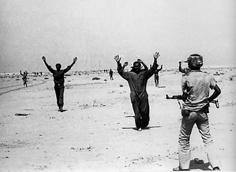
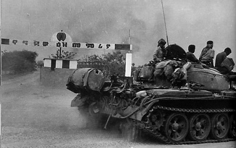
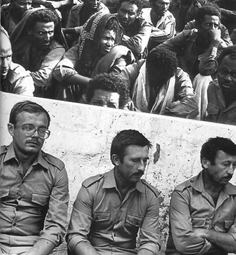
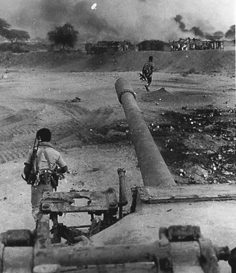
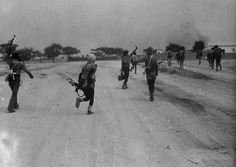
----[This List to be used for Eritrea Related News Only]----
